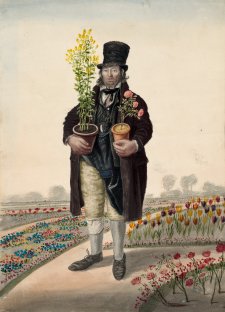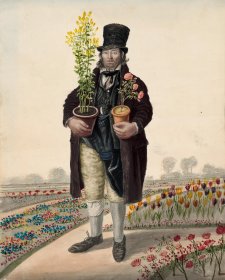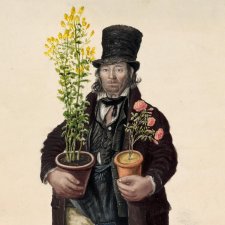- About us
- Support the Gallery
- Venue hire
- Publications
- Research library
- Organisation chart
- Employment
- Contact us
- Make a booking
- Onsite programs
- Online programs
- School visit information
- Learning resources
- Little Darlings
- Professional learning
The manufacture of ready-made clothing, as opposed to tailored garments, seems to have its beginnings in Britain in the 17th century. The nicely named historian of demotic dress, John Styles, suggests that ‘the trend may have been encouraged by the large orders placed for military clothing during the Civil War, by the expansion of shipping and colonial settlement and the accompanying demand for ready-made garments for sailors, indentured servants and plantation slaves, and perhaps by a shift in some men’s and women’s garments to simpler styles’. With these developments reinforced by the increased mechanisation of spinning and weaving, such ‘slop clothing’ had become commonplace by the early 19th century, and was standard issue in the convict settlements of New South Wales and Van Diemen’s Land, for example.
Despite the growth of this new mass market, however, the second-hand wearables trade remained a significant industry. Britain’s garment dealers processed three distinct categories of material: clothes of sufficient quality to be cleaned, mended, re-napped and resold; clothes that, although worn, were ‘good enough to be exported to Ireland, to Australia and the Colonies generally’; and a third class of tattered garments that were shredded into ‘devil’s dust’ or ‘shoddy’, then remade into an inferior grade of cloth. Prominent, visible and distinctly audible in this sector were London’s Jews, who collected old clothes throughout the city and resold them, repaired and renovated, at second-hand shops and markets in Monmouth Street, Holywell Street and at Rag-Fair in Petticoat Lane.
Indeed, the most familiar image of ‘the people’ in Britain in the early 19th century was the figure of the old-clothes man. ‘Old, bearded, gabardined, bent-backed,’ carrying a voluminous sack, wearing two or three old hats on top of his own and with his characteristic cry of ‘O clo’!’, he appears in popular culture from the 17th to the 19th centuries, from Charles Dibdin’s musical Tom Wilkins (1799) to the many illustrations in published Cries of London. The old-clothes men’s widely supposed involvement in handling stolen goods ultimately produces that powerful Semitic caricature, the figure of Fagin in Charles Dickens’ Oliver Twist (1837).
Expelled from England and Wales by Edward I in 1290, Jews were not readmitted until the time of the Commonwealth, but their presence gradually increased through the 17th and 18th centuries; by 1830 it was estimated that there were some 18,000 resident in or near the metropolis.
Mostly Ashkenazim from the Netherlands and Germany, these immigrant communities were prevented from full participation in social, political and economic life, both by legal constraints and by what George Eliot memorably called the ‘pelting contempt’ of anti-Semitism.
Dempsey’s portrait of Samuel Hevens, however, illustrates the inaccuracy or instability of conventional representation. Although unshaven, this man does not have the pointed beard and exaggerated hooked nose of a Shylock. Nor does he wear the traditional long gabardine coat (full-length robes were prescribed by medieval sumptuary laws) and broad-brimmed Ashkenazi barrette, but a perfectly ordinary and contemporary three-piece black suit, with a clean white stock and top hat. The full-frontal pose even obscures the old-clothes-man’s primary attribute, his sack full of sartorial gleanings.
Nothing has been discovered of the life of Samuel Hevens, other than the basic information in Dempsey’s inscription. One other aspect of his portrait, however, is worth noting. It has been observed elsewhere that the artist displays a particular instinct or knack for the subtly repeated form or pattern. Here it is twinned verticals, double closure, with the helical twist of the furled umbrella finding its echo in the spiralling neck of Hevens’s bag.
Collection: Tasmanian Museum and Art Gallery, presented by C. Docker, 1956



Dempsey’s people: a folio of British street portraits 1824–1844 is the first exhibition to showcase the compelling watercolour images of English street people made by the itinerant English painter John Dempsey throughout the first half of the nineteenth century.



Visit us, learn with us, support us or work with us! Here’s a range of information about planning your visit, our history and more!



We depend on your support to keep creating our programs, exhibitions, publications and building the amazing portrait collection!